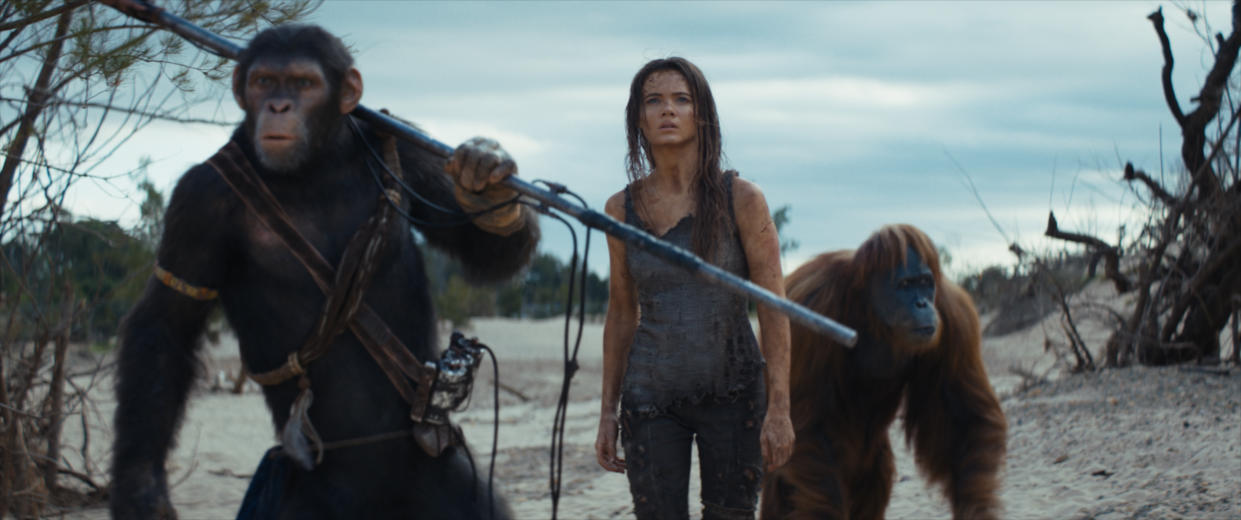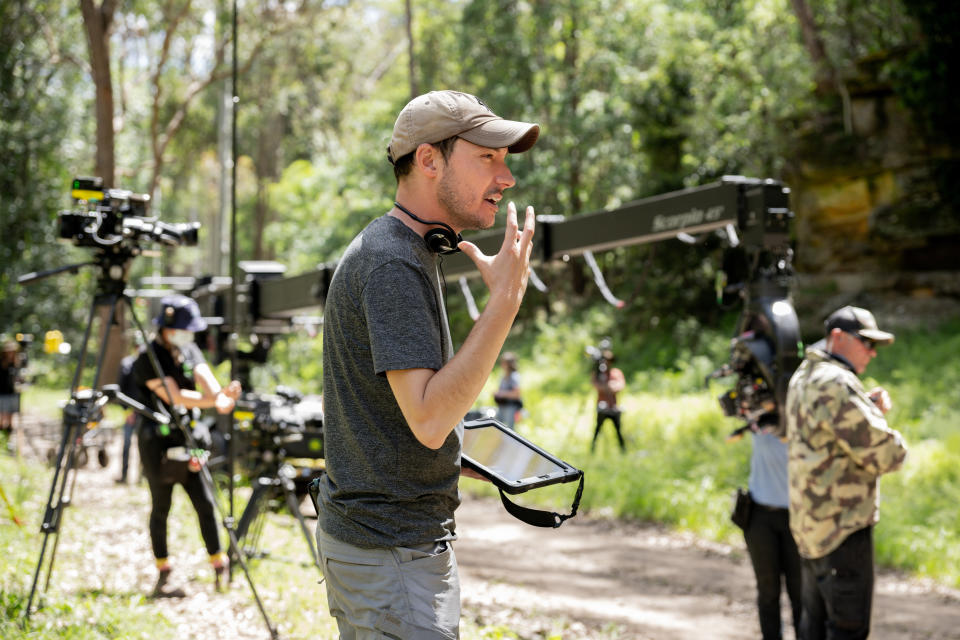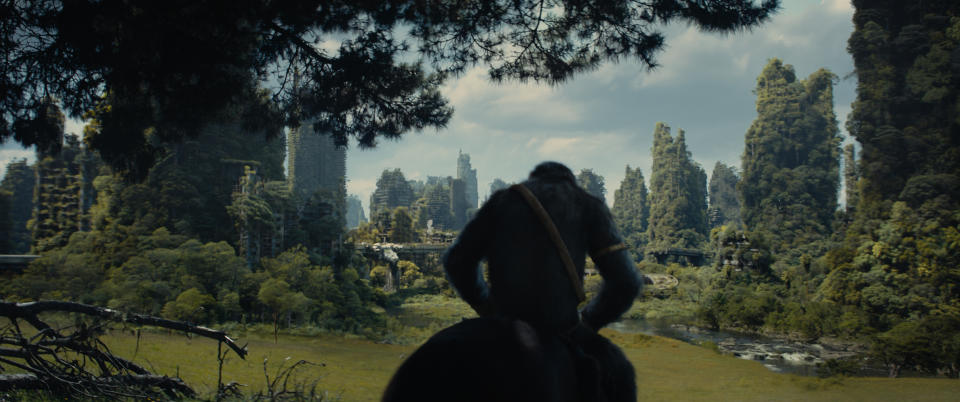How ‘Kingdom of the Planet of the Apes’ Director Wes Ball Paid Homage to the Original

- Oops!Something went wrong.Please try again later.
[Editor’s note: Spoilers for “Kingdom of the Planet of the Apes” below.]
Wes Ball had two things going for him in directing “Kingdom of the Planet of the Apes”: His love of the original franchise, which he first watched on TV as a kid in the ’80s, and his admiration for “Avatar,” whose virtual production and performance capture prowess he leveraged with the help of Wētā FX.
More from IndieWire
Would Adding 'Apes' Character Koba Make Other Movies Better? Social Media Seems to Think So
Jerry Seinfeld Loses His Netflix #1 to Brooke Shields in 'Mother of the Bride'
“Something I’ve always wanted to do is go play in that ‘Avatar’ style and do it here, where there is no camera, there’s no lights, there’s no set really,” Ball told IndieWire. “And you have to create that in the computer with really talented artists. And I had a great time doing it.”
Ball got a taste of the tech working with Wētā on the shuttered “Mouse Guard” adaptation of David Petersen’s graphic novel (a casualty of the Disney/Fox merger). “That’s where I met those guys and Andy Serkis [who was set to star and who served as special consultant on ‘Kingdom’],” he said. “He was really important to me and helped the actors kind of get into their headspace. They had never done this before.”
As IndieWire previously reported, Ball will offer the entire “Kingdom” as a rare before-and-after Blue-ray bonus feature consisting of raw dailies and completed performance capture and VFX. “These are true storytellers at work here. I want to show that off and celebrate it,” added Ball.
The director kicks off his new saga 300 years after the death of Caesar (Serkis) when apes rule the planet, and the remaining intelligent humans immune to the simian virus have been driven underground. The adventure revolves around chimp teenager Noa (Owen Teague), forced to rescue his Eagle Clan (named for bonding with the majestic bird) from the evil clutches of militant chimp ruler Proximus Caesar (Kevin Durand). He has twisted Caesar’s compassionate philosophy to achieve world domination. Along the way, Noa befriends wise orangutan Raka (Peter Macon), who teaches him about Lawgiver Caesar, and Mae, a sort of stand-in for Charlton Heston’s astronaut Taylor, who has a secret agenda for regaining control of the planet.

If this has parallels to “Planet of the Apes,” it’s no coincidence. Ball mines the 1968 sci-fi classic to rework “The Hunt” sequence (including a shout-out to Jerry Goldsmith’s eerie theme by composer John Paesano), bringing Noa and Mae closer together during a thrilling escape in a field of tall grass on horseback. He also pays homage to “The Forbidden Zone” with the ape scarecrows (echoing more Goldsmith score) and “The Cave” (with the familiar talking doll recreating the “Mama” audio track from the original).
At the same time, Ball also interjects allusions to “Beneath the Planet of the Apes” (1970), “Conquest of the Planet of the Apes” (1972), and “Battle for the Planet of the Apes” (1973). He even admits that there are plans to do a sequel to the ’68 original. “It’s in our sights, it’s on the horizon, but there’s a long way to go,” Ball said. “And there’s no push on anyone’s part to do that. So, if I had my choice, you wouldn’t remake the original. You would build up to that, and then you start over, you’d go back and watch that ’68 and just let this franchise in.”
But without the time travel: “Would people accept that today?” Ball added. “I struggle with that but anything’s possible. Those movies go into some wild territory: mutants praying to nuclear weapons [in ‘Beneath’]. That’s a cool idea. Do we literally do mutants? I don’t know. But taking the underlying concept behind it, we will play with all those ideas. We borrow from all of it, so we hopefully feel like we’re a part of this long legacy.”
Ball likens “Kingdom” to a Bronze Age for apes. To him, it’s more historical epic than futuristic sci-fi adventure, asking the eternal question: Can human and ape peacefully co-exist? “I always loved that so much time had passed that erased all evidence of our existence in the ’68 film,” he said. “And then you uncover all of this haunting past of the world that once was that we got to play with here. They couldn’t do that in the previous three movies. They were about the end of the human world; ours is about the beginning of the ape world.”

The apes have now begun developing their own civilization in villages throughout the overgrown Pacific Northwest (shot in New South Wales, Australia) amidst the ruins of decrepit skyscrapers and rusted ships. The apes have clearly evolved, and Wētā has made significant tech refinements to make them look more realistic: They are chattier, they walk more upright, and they ride more prominently on horseback. Additionally, there is more cultural ape identity through face paint and costume, showcased in the natural woven fibers and colorful design of the Noa’s Eagle Clan, as well as the use of metals and armor of Proximus Caesar and his marauders.
In terms of the VFX, Ball is very proud of the 33 minutes of full CG (a franchise first), especially the immense amount of simulated water. The highlight is an action scene with rushing water flooding a weapons silo. “We flooded a converted parking garage with GG water, and I had [the actors] put 20-pound sandbags on their legs and walk through the stage so they pretended like they were in water,” he said. “That was crazy amounts of data. Petabytes and petabytes and petabytes. And we tried very hard to keep a grounded kind of cinema language to it all.”
Moving forward, Ball envisions the Noa/Mae story as a new trilogy, and he’s already mapped out the next two films, grappling with such issues as the importance of technology, continued warfare, the possibility of venturing into space, and, of course, Caesar’s legacy. Ball believes the franchise remains as relevant as ever given our divisive times. “There’s so much story to tell,” he added. “What I like about the franchise is that these movies hold up a mirror to our society, the things we’re going through, and we get to look at ourselves and see humanity through these apes’ eyes.”
Best of IndieWire
The 13 Best Thrillers Streaming on Netflix in May, from 'Fair Play' to 'Emily the Criminal'
The Best Father and Son Films: 'The Tree of Life,' 'The Lion King,' and More
The 10 Best Teen Rebellion Films: 'Pump Up the Volume,' 'Heathers,' and More
Sign up for Indiewire's Newsletter. For the latest news, follow us on Facebook, Twitter, and Instagram.

